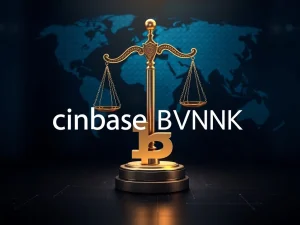Urgent Need: Improved DeFi Security and Compliance to Attract Institutions

Institutional investors are increasingly interested in decentralized finance (DeFi), recognizing its potential to revolutionize traditional finance. However, a significant hurdle remains: the perceived risks associated with DeFi security and the lack of clear DeFi compliance frameworks. To truly unlock institutional capital, the DeFi space must prioritize building trust through robust security measures and adherence to regulatory standards. This article, inspired by Sergej Kunz’s insights, delves into the critical need for these improvements to pave the way for widespread institutional DeFi adoption.
Why Institutional Adoption Hinges on DeFi Security and Compliance
The growth of DeFi has been nothing short of remarkable. Early institutional interest has surged from 10% of hedge funds to nearly half in just four years, with projections indicating further acceleration. Major players like Goldman Sachs and Visa are already dipping their toes into onchain finance, exploring bond issuance, yield farming, and cross-border payments. This burgeoning interest signals a massive opportunity for DeFi, but to fully capitalize on it, the industry must address the concerns of institutional investors head-on. What are these concerns?
- Security Vulnerabilities: High-profile hacks, like the recent $1.4 billion Bybit breach, highlight the real and present dangers in DeFi. Smart contract exploits, multisignature wallet vulnerabilities, and blind signing risks are major deterrents for institutions entrusted with significant capital.
- Regulatory Uncertainty: The absence of clear and consistent regulatory frameworks creates a compliance minefield for institutions. They operate under stringent legal and fiduciary duties, making regulatory ambiguity a significant barrier to entry.
- User Experience Challenges: DeFi platforms often cater to technically savvy users. Institutions require user-friendly interfaces that simplify complex processes like staking and asset management, without necessitating reliance on intermediaries.
These challenges form the “institutional trilemma” of DeFi, where security, compliance, and user experience must be simultaneously addressed to foster trust and encourage widespread institutional adoption.
The Cost of Inaction: DeFi Security Exploits and Compliance Concerns
The DeFi space is no stranger to security incidents. Every year brings a new wave of exploits, costing users and platforms billions of dollars. The Bybit hack, attributed to vulnerabilities in transfer processes and blind signing risks, is a stark reminder of the stakes. These incidents raise serious questions about the maturity of DeFi security protocols and the user experience surrounding transaction approvals. For institutional investors, these are not just abstract risks; they are tangible threats that can lead to substantial financial losses and reputational damage.
Furthermore, the lack of a well-defined regulatory framework leaves institutions in a precarious position. Navigating anti-money laundering (AML) regulations, know-your-customer (KYC) requirements, and other compliance obligations in a decentralized and often opaque environment is incredibly complex. This regulatory uncertainty breeds hesitation and prevents institutions from confidently deploying large sums into DeFi protocols.
Intent-Based Architecture: A Powerful Solution for DeFi Security and Compliance
Emerging technologies like intent-based architecture offer a promising path forward for enhancing both DeFi security and DeFi compliance. This architectural approach fundamentally shifts how transactions are processed, focusing on user intent rather than complex manual execution. How does this improve security and compliance?
- Mitigating MEV Exploits: Intent-based systems are designed to reduce risks associated with Miner Extractable Value (MEV). By abstracting away the complexities of trade execution, they protect users from predatory bots that scan for and exploit profitable trades.
- Enforcing Compliance Frameworks: This architecture allows for the implementation of robust compliance measures directly into the transaction flow. For example, systems can be designed to restrict order submissions to verified “clean” wallets and ensure that resolvers only settle compliant orders.
- Reducing Counterparty Risk: Traditional DeFi often relies on intermediaries like liquidity providers, introducing counterparty risk. Intent-based systems promote trustless settlement, ensuring transactions execute only when all predefined conditions are met. This eliminates the need for blind trust and significantly reduces potential risks.
- Improving User Experience (UX): By simplifying the interaction process, intent-based architecture makes DeFi more accessible to institutional investors who may lack deep technical expertise. It bridges the gap between the complexity of DeFi and the usability expectations of traditional finance players.
While integrating offchain order matching with onchain transparency presents challenges, the benefits of intent-based architecture in bolstering DeFi security and streamlining DeFi compliance are undeniable.
The Competitive Edge of Early Institutional DeFi Adoption
The transition to onchain finance is not a matter of if, but when. Early adopters of DeFi stand to gain a significant competitive advantage. Access to enhanced liquidity and attractive yield opportunities are just the tip of the iceberg. Institutions that proactively embrace DeFi now will be better positioned to navigate the evolving regulatory landscape and establish themselves as leaders in the future of finance.
Conversely, late adopters risk falling behind. By 2026, institutions that have hesitated to explore DeFi may find themselves struggling to catch up with competitors who have already integrated onchain finance into their operations. The examples of JPMorgan and Citi’s early tokenization projects underscore this point – TradFi leaders are already preparing for the onchain future.
Charting the Path Forward: Collaboration for Secure and Compliant DeFi
To facilitate broader institutional adoption, a collaborative effort is essential. Regulatory bodies, supervisory agencies, and policy leaders must work together to establish clear and standardized guidelines. DeFi platforms, in turn, must proactively build the necessary security and compliance infrastructure to meet institutional requirements.
This requires a multi-pronged approach:
- Clear Regulatory Clarity: Providing well-defined and consistent regulations is paramount to removing the compliance uncertainty that currently deters institutional investors.
- Standardized Protocols: Developing uniform protocols for security, compliance, and interoperability will foster trust and facilitate wider institutional participation.
- Technological Innovation: Continued development and adoption of technologies like intent-based architecture are crucial for enhancing security and streamlining compliance processes.
- Industry Collaboration: Open dialogue and collaboration between regulators, developers, and institutions are essential to building a secure, compliant, and thriving DeFi ecosystem.
The future of finance is undoubtedly intertwined with DeFi. By prioritizing DeFi security and DeFi compliance, and fostering collaboration across the industry, we can unlock the transformative potential of decentralized finance and usher in a new era of institutional participation.







